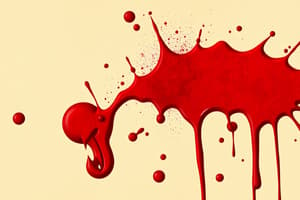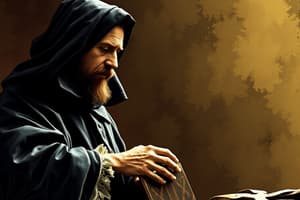Podcast
Questions and Answers
What does the eagle symbolize in Macbeth?
What does the eagle symbolize in Macbeth?
- Weakness and fear
- Inspiration and masculinity (correct)
- Wisdom and guidance
- Death and destruction
What is the sparrow used to represent in Macbeth?
What is the sparrow used to represent in Macbeth?
A bird that is killed by birds of prey
What does the raven symbolize in Macbeth?
What does the raven symbolize in Macbeth?
Darkness, destruction, and evil
What does the mythical bird 'martlet' symbolize?
What does the mythical bird 'martlet' symbolize?
What symbolism does the crow carry in Macbeth?
What symbolism does the crow carry in Macbeth?
What do magpies represent in Macbeth?
What do magpies represent in Macbeth?
What is the symbolism behind the chough in Macbeth?
What is the symbolism behind the chough in Macbeth?
What does the owl symbolize in Macbeth?
What does the owl symbolize in Macbeth?
In Macbeth, what does the falcon represent?
In Macbeth, what does the falcon represent?
What does the wren symbolize in Macbeth?
What does the wren symbolize in Macbeth?
What fear does the kite represent in Macbeth?
What fear does the kite represent in Macbeth?
What qualities does the goose symbolize in Macbeth?
What qualities does the goose symbolize in Macbeth?
What symbolism does the hawk have in Macbeth?
What symbolism does the hawk have in Macbeth?
Flashcards
Eagle symbolism
Eagle symbolism
Represents inspiration, strength, and pride in Macbeth.
Sparrow's fate
Sparrow's fate
Killed by birds of prey, contrasting with the eagle's strength.
Raven's meaning
Raven's meaning
Symbolises darkness, destruction, and evil in Macbeth.
Martlet's quest
Martlet's quest
Signup and view all the flashcards
Crow's role
Crow's role
Signup and view all the flashcards
Magpie's nature
Magpie's nature
Signup and view all the flashcards
Chough's symbolism
Chough's symbolism
Signup and view all the flashcards
Jackdaw's role
Jackdaw's role
Signup and view all the flashcards
Owl's duality
Owl's duality
Signup and view all the flashcards
Falcon and royalty
Falcon and royalty
Signup and view all the flashcards
Owl vs. Falcon
Owl vs. Falcon
Signup and view all the flashcards
Wren's courage
Wren's courage
Signup and view all the flashcards
Kite's ancient fear
Kite's ancient fear
Signup and view all the flashcards
Goose's symbolism
Goose's symbolism
Signup and view all the flashcards
Hawk's nature
Hawk's nature
Signup and view all the flashcards
Macbeth's arrogance
Macbeth's arrogance
Signup and view all the flashcards
Macbeth's view of the dead
Macbeth's view of the dead
Signup and view all the flashcards
Lady Macduff and wren
Lady Macduff and wren
Signup and view all the flashcards
"Hell-kite"
"Hell-kite"
Signup and view all the flashcards
Study Notes
Eagle
- Represents inspiration, masculinity, strength, and pride.
- Featured in Act I, Scene ii.
Sparrow
- Killed by birds of prey, highlighting the eagle's strength.
- Mentioned in Act I, Scene ii.
Raven
- Symbolizes darkness, destruction, and evil.
- Acts as an ill omen; referenced in Act I, Scene v.
Martlet
- A mythical bird similar to a swallow, lacking legs due to short tufts of feathers.
- Represents the constant quest for knowledge; mentioned in Act I, Scene vi.
Crow
- Signifies magic, mystery, and death; often seen as a trickster and manipulative.
- Considered an ill omen; appears in Act III, Scene ii and Act III, Scene iv.
Magpies
- Viewed as prophets or discoverers of evil, stereotyped to steal shiny objects.
- Symbolically parallels Macbeth's act of seizing the crown by murdering Duncan, seen in Act III, Scene iv.
Chough
- Related to magpies and similarly represents prophets of evil.
- Shares symbolic parallels with Macbeth's actions; found in Act III, Scene iv.
Jackdaw
- Same family as magpies; functions as a prophet of evil in the narrative.
- Reflects the theme of stealing despite the modern belief against this behavior; referenced in Act III, Scene iv.
Owl
- Symbolizes wisdom but is also associated with death and witchcraft.
- Its cry heralds death, welcomed by Lady Macbeth as a sign of Duncan's murder; includes multiple scenes.
Falcon
- Emblematic of royalty, speed, and swiftness; favored by the elite for hunting.
- The owl's act of killing the falcon emphasizes a bad omen, seen in Act II, Scene iv.
Wren
- Noted in various Shakespeare texts, small in size yet courageous.
- Lady Macduff likens herself to a wren defending her young against the deadly owl, found in Act IV, Scene ii.
Kite
- Kites equated to hawks; symbolizes ancient fears of carrion birds disturbing the dead.
- Macbeth expresses a desire for the dead to remain at peace, discussed in Act III, Scene iv and Act IV, Scene iii.
Goose
- Symbolizes guidance and stability but carries a reputation of sluggishness.
- Macbeth's reference to "10,000 geese" reflects overconfidence and his belief in his invincibility, seen in Act V, Scene iii.
Hawk
- Represents war and has a hard, unyielding nature.
- Often associated with malevolence; Macduff refers to an evil "Hell-kite" that preys on the innocent, found in Act III, Scene iv and Act IV, Scene iii.
Studying That Suits You
Use AI to generate personalized quizzes and flashcards to suit your learning preferences.




